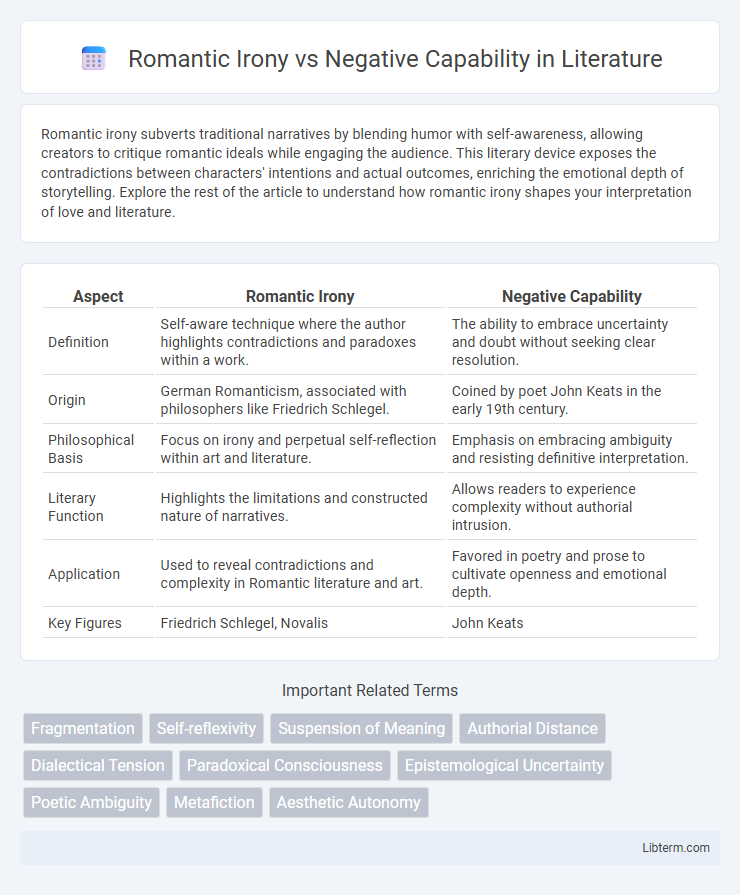Romantic irony subverts traditional narratives by blending humor with self-awareness, allowing creators to critique romantic ideals while engaging the audience. This literary device exposes the contradictions between characters' intentions and actual outcomes, enriching the emotional depth of storytelling. Explore the rest of the article to understand how romantic irony shapes your interpretation of love and literature.
Table of Comparison
| Aspect | Romantic Irony | Negative Capability |
|---|---|---|
| Definition | Self-aware technique where the author highlights contradictions and paradoxes within a work. | The ability to embrace uncertainty and doubt without seeking clear resolution. |
| Origin | German Romanticism, associated with philosophers like Friedrich Schlegel. | Coined by poet John Keats in the early 19th century. |
| Philosophical Basis | Focus on irony and perpetual self-reflection within art and literature. | Emphasis on embracing ambiguity and resisting definitive interpretation. |
| Literary Function | Highlights the limitations and constructed nature of narratives. | Allows readers to experience complexity without authorial intrusion. |
| Application | Used to reveal contradictions and complexity in Romantic literature and art. | Favored in poetry and prose to cultivate openness and emotional depth. |
| Key Figures | Friedrich Schlegel, Novalis | John Keats |
Introduction to Romantic Irony and Negative Capability
Romantic Irony involves a self-aware narrative technique where the author acknowledges the artificiality of the text, creating a playful tension between reality and illusion. Negative Capability, coined by John Keats, refers to the poet's ability to embrace uncertainty and ambiguity without seeking definitive answers. Both concepts explore the relationship between creator and creation, emphasizing openness to multiple interpretations over fixed meanings.
Origins and Historical Context
Romantic Irony originated in early 19th-century German Romanticism, particularly through the works of Friedrich Schlegel, emphasizing a self-aware tension between art and reality that continually questions its own sincerity. Negative Capability, coined by John Keats in the early 19th century amidst the Romantic literary movement in England, describes the artist's ability to embrace uncertainty and doubt without the need for logical resolution. Both concepts emerged as responses to Enlightenment rationalism, reflecting a shift toward valuing imagination, ambiguity, and the complexities of human experience in art and literature.
Key Philosophers and Poets
Romantic Irony, prominently explored by philosopher Friedrich Schlegel, emphasizes self-reflective, paradoxical art that reveals its own artificiality, challenging fixed meanings and embracing indefinite interpretation. In contrast, Negative Capability, coined by poet John Keats, centers on the poet's capacity to remain comfortable amid uncertainty and ambiguity without seeking rational explanation or closure. While Schlegel's Romantic Irony highlights the tension between appearance and reality in creative expression, Keats' Negative Capability prioritizes intuitive acceptance of mystery as essential to poetic insight.
Defining Romantic Irony
Romantic Irony is a literary device characterized by an author's self-consciousness and playful awareness of the artificiality of their work, often breaking the illusion of reality to engage readers in critical reflection. Unlike Negative Capability, which emphasizes embracing uncertainty and ambiguity without seeking clear resolution, Romantic Irony highlights the tension between creation and destruction within the narrative. This technique originated in German Romanticism and was later theorized by scholars like Schlegel, who emphasized the interplay between infinite possibilities and the limits of finite expression.
Understanding Negative Capability
Negative Capability, a concept coined by John Keats, emphasizes the artist's ability to embrace uncertainty, doubt, and ambiguity without seeking rational explanations or definitive answers. Unlike Romantic Irony, which highlights self-awareness and the tension between reality and artistic illusion, Negative Capability prioritizes emotional depth and the acceptance of mystery as central to creative expression. Understanding Negative Capability enriches appreciation of poetry and art by valuing intuitive insight over logical resolve.
Core Differences and Similarities
Romantic Irony emphasizes the self-awareness of the artist and the instability of meaning, highlighting the contrast between illusion and reality, while Negative Capability centers on embracing uncertainty and doubt without seeking definitive answers. Both concepts value ambiguity and resist rigid interpretations, allowing complex emotional or intellectual experiences. The core difference lies in Romantic Irony's reflective detachment versus Negative Capability's acceptance of mystery as a creative and existential state.
Literary Techniques and Applications
Romantic Irony employs self-referential and paradoxical narration to highlight the artificiality of literary creation, often breaking the fourth wall and emphasizing the author's presence within the text. Negative Capability, a concept popularized by John Keats, embraces uncertainty and ambiguity, allowing poets and writers to accept unresolved tensions without forcing conclusions, thereby enriching the emotional depth and complexity of literary works. Both techniques deeply influence Romantic literature, with Romantic Irony foregrounding the creative process and Negative Capability fostering open-ended interpretation and imaginative engagement.
Impact on Romantic Literature
Romantic Irony, characterized by self-reflective awareness and the tension between author and narrative, challenged traditional storytelling and deepened readers' engagement with ambiguity and uncertainty in Romantic literature. Negative Capability, coined by John Keats, emphasized embracing uncertainty and doubt without the need to resolve contradictions, fostering a nuanced exploration of human experience and emotional complexity. Both concepts profoundly influenced Romantic literature by encouraging innovative narrative techniques and expanding thematic richness beyond rational explanation.
Influence on Modern Thought
Romantic Irony, emphasizing self-awareness and the paradoxes within artistic creation, challenged fixed interpretations and inspired postmodern skepticism about objective truth. Negative Capability, defined by John Keats as the capacity to embrace uncertainty and doubt without seeking definitive answers, profoundly influenced existentialist and phenomenological philosophies by prioritizing ambiguity and subjective experience. Both concepts reshaped modern thought by questioning absolute knowledge, encouraging intellectual humility, and fostering a more nuanced understanding of human consciousness and creativity.
Conclusion: Lasting Legacy in Literature
Romantic irony and negative capability have profoundly shaped literary expression by emphasizing the complexities of human experience and authorial uncertainty. Romantic irony highlights the tension between the creator and creation, fostering self-awareness and critical reflection within texts. Negative capability, championed by John Keats, promotes embracing ambiguity without the need for resolution, inspiring writers to explore nuanced emotional and intellectual landscapes, thus leaving a lasting legacy of depth and introspection in literature.
Romantic Irony Infographic

 libterm.com
libterm.com